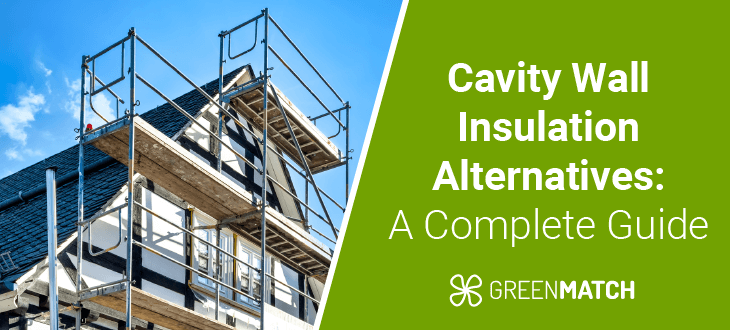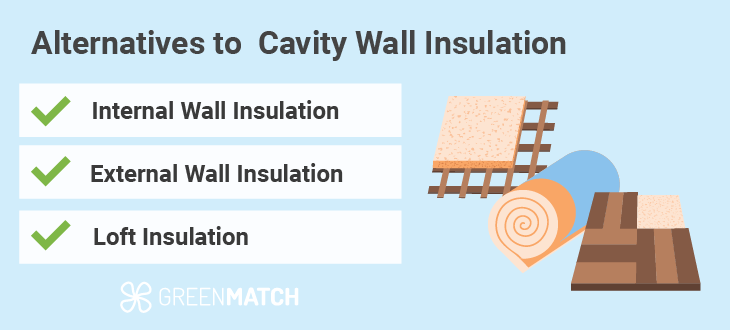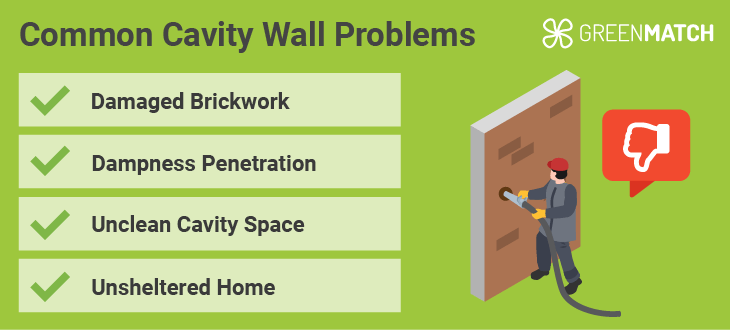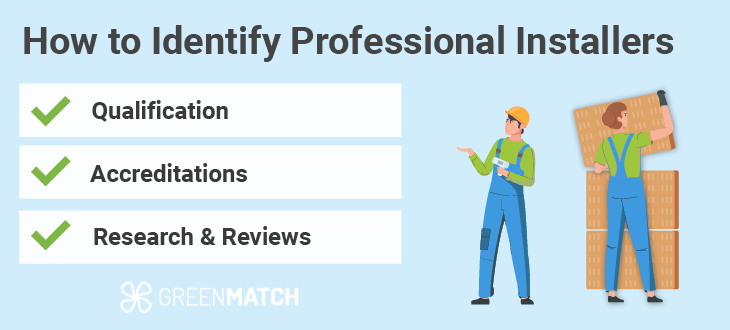Answer these simple questions and we will find you the BEST prices
Which type of solar quotes do you need?
It only takes 30 seconds
100% free with no obligation

Get Free quotes from insulation specialists near you

Save money by comparing quotes and choosing the most competitive offer

The service is 100% free and with no obligation
- GreenMatch
- Insulation
- Wall Insulation
- Cavity Wall Insulation
- Cavity Wall Insulation Alternatives
What Are the Alternatives to Cavity Wall Insulation (2025)?


- Uninsulated walls are responsible for up to 33% of heat loss in a home.
- Up to 8.5 million homes in the UK don’t have cavity walls, but solid walls instead.
- Some alternatives to cavity wall insulation are internal and external wall insulation.
While cavity walls are a popular build type across the UK, not all homes have these types of walls. Almost all pre-1920 properties in the UK are solid wall properties, of which a staggering 90% remain uninsulated according to the Solid Wall Insulation Guarantee Agency (SWIGA). This is reflected in sky-high energy bills, damp drafty homes, and big domestic carbon footprints.
Luckily, there are plenty of cavity wall insulation alternatives available for homes with different circumstances. These options are just as effective in reducing your home heat loss, leading to big energy savings, a healthier home environment, and a greater contribution to sustainability.
This ultimate GreenMatch UK guide will walk you through the various insulation alternatives to cavity wall insulation, and in which cases should you consider them.
Ready to insulate your home? Let GreenMatch UK free you from the tedious burden of researching and vetting installers. Instead of spending endless hours locked in on websites and phone calls, spend just 30 seconds filling out our 30-second online form to receive up to 3 free home-tailored quotes. No hidden charges, no obligations required. Click below to begin!
Fill in the form in just 1 minute
What are the alternatives to cavity wall insulation?

Cavity wall insulation, as suggested by its name, is only suitable for cavity wall properties. These are homes with two wall leaves (outer wall and inner wall) with a cavity space in between. A sizeable portion of UK homes instead have solid walls, which are made of a single-layer brick wall with no cavity space.
The two main alternative wall insulation approaches for solid walls are internal wall insulation and external wall insulation. Both insulation approaches are slightly more complex than cavity wall insulation, but just as effective in retaining home heat and improving efficiency.
For homes wanting to improve their energy efficiency without insulating walls, loft insulation can serve as another impressive heat retention avenue.
While not sustainable long-term fixes, there are small DIY hacks that can work as great cavity wall insulation alternatives in helping retain home heat!
Thermal liner is an ultra-thin wallpaper with insulating properties that can be added to your inner walls and painted over. It helps to act as an insulating barrier whilst also controlling wall breathability, helping to avoid moisture buildup.
A similar alternative is insulating paste. Found in most hardware stores, it works similarly to wall plaster and can be applied on the inside of your property before adding wallpaper or painting. It can provide a small boost to your home’s heat retention.
Internal wall insulation
Internal wall insulation is a great alternative if you do not have a cavity wall property. Alternatively, you can get internal wall insulation if your cavity walls are unsuitable for insulation.
The process costs around £7,500 for a typical 3-bedroom semi-detached home, but this price can fluctuate depending on several factors like home size, type and installation complexity.
Whilst it is a relatively disruptive process that takes place on the inside of your home, it is a long-term solution that will boost your energy efficiency significantly. There are generally two different approaches to internal wall insulation:
- Dry lining involves fixing rigid insulation boards directly to the existing walls, and then covering them with plasterboard.
- Stud walls are when timber frames are built out from the existing wall to create a cavity, which is filled with insulation like mineral wool, fibreglass, or sheep wool.
Both methods take place within the inside of your home and can be handled all in one go, or room by room depending on your budget, installation complexity and personal needs.
- Cost-effective: Internal insulation is generally cheaper than external methods.
- Improved comfort: The insulation helps retain heat, leading to lower energy bills and a warmer, more comfortable living environment.
- Enhanced soundproofing: While not made for soundproofing, internal wall insulation can dampen noise from outside and between rooms.
- Preserve exterior appearance: Unlike external insulation, this method doesn’t alter the facade of your home.
- Disruptive installation: The process can be messy and inconvenient, as it involves removing and replacing fixtures like door frames and skirting boards.
- Space reduction: Internal insulation slightly reduces the available floor space within each room.
- Professional installation recommended: Due to the potential for damp issues if not done correctly, it’s often recommended to have professionals handle the installation.
External wall insulation
External wall insulation is an effective wall insulation that can be added to either solid or cavity walls. It involves fixing rigid insulation boards directly onto the outer walls of your home, then covering it with render (plaster) and cladding insulation. This process generally costs around £12,000, but can fluctuate on home and personal circumstances.
External wall insulation is highly effective at keeping your home warm and reducing energy bills. It minimises heat loss through the walls, a major source of energy inefficiency. Also, fixing cracks and gaps reduces drafts and creates a more consistent indoor temperature.
- Maintains interior space: Unlike internal insulation, this method doesn’t eat into your living space.
- Improved durability: External insulation protects your brickwork from harsh weather conditions, potentially extending its lifespan.
- Reduced moisture problems: Addressing thermal bridging (cold spots), helps prevent condensation and dampness issues within the walls.
- Potential planning permission: Depending on your location, you might need planning permission to alter your property’s external appearance.
- Importance of sealing: Improper sealing around windows and doors can create “cold bridges,” negating the insulation benefits.
- Cost and environmental impact: While highly effective, external wall insulation can be more expensive than internal options. Additionally, some materials have a higher environmental footprint during production.
Loft insulation
Loft insulation can be an alternative way to insulate your home other than cavity wall insulation, but as its name suggests, this is not wall insulation.
Loft insulation is when insulating material is installed in your loft to minimise heat loss and temperature change in your home. This works by trapping heat in air pockets, keeping your home warm during winter and cool during summer.
Costing around £930 for a semi-detached UK house, loft insulation helps offset up to a quarter of home heat loss, making it a formidable alternative to wall insulation. There are two main ways to insulate a loft:
- Warm loft insulation is best for a living space. This is when insulation is laid between the roof rafters, secured in place, and covered up with plasterboard. The inner walls of the living area will also need to be insulated for optimal heat retention. Any windows and skylights also need glazing and draught proofing.
- Cold loft insulation is best for storage purposes. This is when the loft floor is insulated to keep the rest of your house warm, but leaves your loft cold. It’s done by lifting the floorboards and adding 270mm of mineral wool in between the joists before closing it up.
- Better heat retention: Even if your home has uninsulated walls, loft insulation can help offset some of the heat loss. For the best result, both your walls and loft must be insulated.
- Affordable: Loft insulation is one of the most budget-friendly insulation options for a home, making it far more accessible to households than wall insulation.
- Effectiveness: Loft insulation on its own is not as effective at retaining heat without accompanying wall insulation. The same is true vice versa.
What properties necessitate cavity wall insulation alternatives?

If you live in a cavity wall property, then chances are getting cavity wall insulation is your best bet. However, some cavity walls (especially older homes) may host a series of problems and neglected repairs that make them unsuitable for cavity wall insulation.
Some of the key problems cavity walls can experience are:
- Damaged brickwork: Older walls may have brickwork that has accrued damage over time. Surface cracks and gaps can compromise the airtight seal of the cavity wall, resulting in moisture buildup, mould and mildew.
- Dampness penetration: Older walls that are no longer as airtight can suffer from ongoing cavity wall insulation damp issues. This is usually common with walls exposed to wind-driven rain, leading to water penetration that will damage your insulation.
- Unclean cavity space: Cavity spaces that have debris, or carry old outdated insulation, are unsuitable for new insulation without completely cleaning out the cavity space. Otherwise, the insulation material may suffer a premature loss of efficiency. If your cavity space has wires in it, these would also need to be relocated before an insulation job.
- Unsheltered home: Cavity wall insulation is most at risk when your home is constantly exposed to harsh weather. In the UK, dreary damp conditions are far too common and overexposed walls can suffer from quicker damage than sheltered walls.
Nevertheless, it’s best suggested to try and address existing cavity wall issues before attempting an alternative insulation method. This is because cavity wall insulation is one of the quickest, most affordable, and non-invasive wall insulation methods on the market.
A home assessment by a professional installer can identify whether your cavity wall issues are worth fixing, or whether an alternative wall insulation approach would make the most sense.
What is the best alternative to cavity wall insulation?
With all things considered, the best alternative to cavity wall insulation will depend on your circumstances, such as whether you are aiming for budget or insulation efficiency.
From a budget-friendly perspective, short-term fixes like thermal liner and insulating paste may help offset some heat loss, but internal wall insulation would be your best bet for a long-term and effective solution.
However, internal wall insulation is a notoriously invasive procedure that will very much disrupt your living environment. That's why the best alternative in terms of comfort would likely be external wall insulation, as the entire job takes place outside of your home.
Compare multiple quotes to get the best deal on any insulation

Before diving into insulation installation, secure the best value for your project by comparing quotes from qualified professionals. Here's what you need to know:
- Qualifications matter: Look for CIGA (Cavity Insulation Guarantee Agency) certified installers if you have cavity walls. CIGA ensures professionalism and offers up to a 25-year guarantee on work. For solid walls, choose SWIGA (Solid Wall Insulation Guarantee Agency) certified installers. It's the equivalent accreditation for solid wall insulation.
- PAS accreditation: Opt for installers accredited by PAS 2030-2035 regulations. These government-approved standards ensure they meet proper installation requirements. PAS accreditation is mandatory for grant-funded insulation projects.
- Research and reviews: While price is important, don't settle for the first quote. Research potential installers by reading their online reviews to get a feel for client satisfaction and experiences. If feasible, you can request reviewers to see completed projects firsthand.
Comparing multiple quotes from a range of qualified installers can be a stressful and time-consuming process, but it’s your best bet for landing the perfect bargain. However, you don’t have to do it alone, as GreenMatch UK can take care of the research and betting for you!
With our simplified services, you can be connected with our nationwide network of pre-vetted, qualified professionals with competitive pricing in just a few clicks. Instead of spending endless hours on websites and phone calls, simply fill out our 30-second online form and receive up to 3 free home-tailored quotes from installers right in your area. The best part? Our services are completely free of charges and obligations. Click below to begin!
Fill in the form in just 1 minute
FAQ
Walls without a cavity are likely solid walls. These types of walls are made up of a single brick later with no cavity space in between. Solid walls can be insulated with two approaches: internal wall insulation or external wall insulation.
Although cavity wall insulation is great at helping heat retention, the cavity space also serves the purpose of protecting the inner wall from coming into contact with the moist outer wall. A completely packed cavity space can create a bridge between the two walls, inviting moisture buildup, and even mould growth.

Akif is a copywriter at GreenMatch since 2023. With a keen interest in community sustainability, green solutions and the role of digital media in identifying climate trends, he aims to hone in on his background in International Studies and Digital Media to provide a multidisciplinary approach to written content rooted in credible research and accuracy.
We strive to connect our customers with the right product and supplier. Would you like to be part of GreenMatch?

